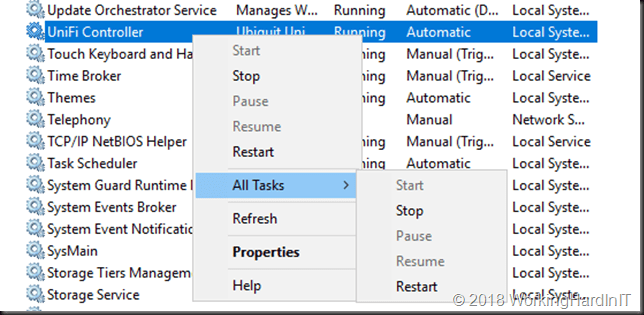

- #Unifi controller run as service how to
- #Unifi controller run as service install
- #Unifi controller run as service update
- #Unifi controller run as service software
- #Unifi controller run as service download

cd /Applications/UniFi.app/Contents/Resources/ And remember that you'll need to use Java 8. I've found that starting Network Controller appears to hang unless I cd to a specific directory. See this help article for the list of ports. You might need to unblock specific ports, instead.
#Unifi controller run as service software
#Unifi controller run as service install
#Unifi controller run as service download
Look for "UniFi Network Controller for macOS" on the Unifi download page. This works fine and isn't tremendously difficult to get running, but it is unfortunately more work than it should be. However, after having gone through the steps to install natively I'll say that the idea of using a Docker container is quite appealing. I haven't tried to use it and don't know how hard it is to get up and running or how well it works, so unfortunately I can't compare it to the other option. The LinuxServer.io team maintains a Docker image for the UniFi Network Controller.
#Unifi controller run as service update
After the update is complete, run “java -jar lib\ace.jar startsvc” (without quotes) to start the service for the updated controller instance.I'm aware of two different ways to do this. When upgrading the service, first perform step 2 and 3, then run “java -jar lib\ace.jar stopsvc” (without quotes) to stop the old the service. For the UniFi cloud service () to work properly you need to use 圆4 Java only (so choose Windows 圆4 Offline). Note: You will need to use Oracle Java JRE 8, which you can download HERE. To access the controller you need to open your browser and go to Alternatively you can use the desired interface IP, or FQDN that is mapped to that host (in place of “localhost”). There is no longer a controller applet, like that other window that popped up. Close the command prompt window either by entering the “exit” command, or clicking the X.ħ. Once you’re at a new command prompt line, after it says “Complete Installation…”, issue the following:Ħ.

Once in the root of the UniFi folder, issue the following (this installs the UniFi Controller service):ĥ. Change directory to the location of UniFi in your computer using the following command (exactly as it is here, no substituting needed):Ĥ.

For example, on Windows 10, right click on the Start Menu and choose “Command Prompt (Admin)”.ģ. Open the command prompt as an Administrator. This is needed to generate some required files for the service to work.Ģ. Once it says “UniFi Controller (a.b.c) started.” you can close the controller program. If you just installed the UniFi controller, make sure to open it once by using the icon on the desktop or within the start menu. Close any instances of the UniFi software on the computer.
#Unifi controller run as service how to
Steps – How to Run the Controller as a Windows Serviceġ.


 0 kommentar(er)
0 kommentar(er)
